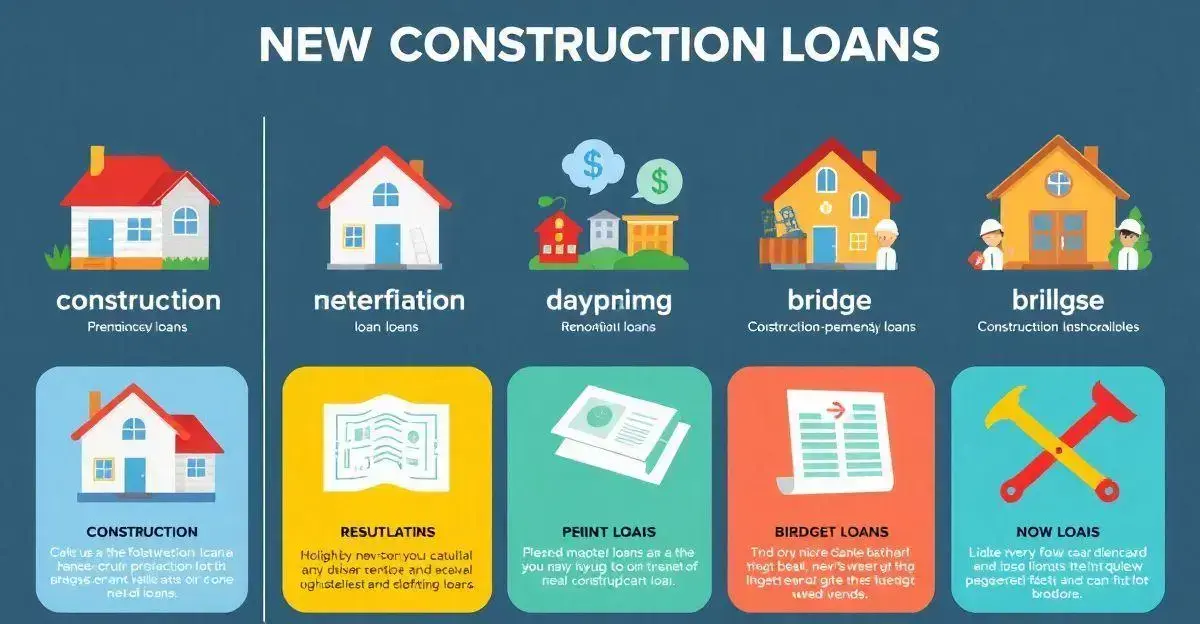New construction loans for investors are key to turning ambitious projects into reality. They provide the funding needed for land, materials, and labor, catering specifically to the unique demands of construction projects.
For investors, understanding how these loans work can make all the difference. With options tailored to various needs, they open doors to higher returns and greater flexibility in the real estate market.
Curious about how these loans can boost your investments? Keep reading to uncover the details and gain the confidence to take your projects to the next level.
Understanding New Construction Loans
- Types of New Construction Loans: There are generally two types of new construction loans: construction-to-permanent loans and stand-alone construction loans. Construction-to-permanent loans convert into a mortgage after the building is completed, which can simplify the financing process. In contrast, stand-alone loans require you to secure separate financing once construction finishes.
- Pay Attention to Interest Rates: Interest rates can vary depending on credit score, loan amount, and lender. Typically, they may start lower than traditional mortgages but will adjust during the construction period. It’s essential to shop around for the best rates to ensure optimal financial outcomes.
- Documentation and Approval: Investors must prepare to document their financial history, project plans, and expected timelines. This information helps lenders assess risk and make informed decisions.
In summary, understanding new construction loans not only improves your chances for securing funding but also enhances your overall investment strategy.
Types of New Construction Loans Available

There are two main types of new construction loans that investors should consider: construction-to-permanent loans and stand-alone construction loans. Understanding the differences between these can significantly impact your financing strategy.
- Construction-to-Permanent Loans: These loans cover the cost of construction and then automatically convert to a permanent mortgage once building is complete. This option simplifies the process by reducing the need for multiple loans and closing costs.
- Stand-Alone Construction Loans: Unlike the previous type, these are short-term loans that only cover the construction phase. After completing the project, you will need to secure additional financing to pay off the construction loan, which could complicate the process.
- Factors to Consider: When choosing among these options, think about the interest rates, loan duration, and total cost. Construction-to-permanent loans often have lower rates, but stand-alone loans may provide more flexibility if you intend to refinance quickly.
Benefits of New Construction Loans for Investors
New construction loans offer several benefits for investors aiming to expand their portfolios. These loans provide the necessary funds to build properties, allowing investors to tap into opportunities in the real estate market.
- Access to Capital: One of the primary benefits is increased access to capital for new projects. With these loans, you can finance a significant part of the construction costs, minimizing your upfront expenses.
- Potential for Higher Returns: Investing in new construction can lead to higher returns. By building from the ground up, investors can create properties that meet current market demands and command higher rental or resale prices.
- Customization: New construction loans enable you to build properties that fit your vision. This customization can attract more tenants or buyers, giving you a competitive edge.
- Building Equity: As construction progresses, you build equity in the property, which can be leveraged for future investments. This equity can serve as a financial tool for further project funding.
In summary, the benefits of new construction loans for investors extend beyond mere financing. They provide opportunities for growth, increased profitability, and a chance to tailor your investments to meet market needs.
How to Qualify for a New Construction Loan

Qualifying for new construction loans for investors involves several key steps that every investor should follow. These loans are different from traditional mortgages, and understanding the requirements can help you secure funding more easily.
- Credit Score: One of the main factors lenders consider is your credit score. A higher score can lead to better interest rates and loan terms. Aim for a score above 620 to improve your chances of approval.
- Down Payment: Lenders typically require a down payment ranging from 10% to 20% of the total loan amount. Having this cash ready demonstrates your financial commitment and can strengthen your application.
- Debt-to-Income Ratio (DTI): Your DTI shows how much of your income goes toward debt payments. Most lenders prefer a DTI below 43%. Keeping your debts manageable is crucial for loan qualification.
- Documentation: Be prepared to provide comprehensive documentation. This includes tax returns, pay stubs, bank statements, and details of the construction project. Organized documentation can expedite the approval process.
- Construction Plans: Clear and realistic construction plans are essential. Lenders need to see a detailed budget, timeline, and the qualifications of your builder. This information helps them evaluate the project’s feasibility.
Following these steps can significantly improve your chances of qualifying for a new construction loan, allowing you to move forward with your investment plans.
Common Mistakes to Avoid with Construction Loans
When applying for new construction loans for investors, it’s common to encounter mistakes that can hinder approval. Avoiding these errors can lead to smoother financing and more successful projects.
- Lack of Proper Planning: One major mistake is failing to plan adequately for the construction project. This includes having a clear budget, timeline, and construction goals. Without a detailed plan, lenders may view you as a high-risk borrower.
- Ignoring the Importance of Credit: Many investors underestimate the impact of their credit score on loan approval. A low score can result in higher interest rates or even rejection. Checking your credit beforehand and addressing any issues is essential.
- Insufficient Documentation: Not providing enough documentation can delay or derail your loan application. It’s crucial to gather all necessary paperwork, such as income statements, tax returns, and project plans to ensure a smooth process.
- Overestimating Property Value: Some investors may overestimate the future value of their new construction, which can lead to unrealistic loan amounts. Being realistic about projections helps in gaining lender trust.
- Skipping Professional Advice: Neglecting to consult with professionals, such as loan officers or real estate agents, is a common error. Their insights can help you avoid pitfalls and guide you through the process.
By avoiding these common mistakes, investors can enhance their chances of securing new construction loans and achieving their investment goals.
Tips for Choosing the Right Lender

Choosing the right lender for new construction loans for investors is a critical step in ensuring a smooth and efficient financing process. The right choice can simplify your project, while the wrong one may lead to unnecessary complications.
- Research Multiple Lenders: Start by researching several lenders. Look for those who specialize in construction loans as they understand the unique requirements and risks involved. Don’t settle for the first offer; compare terms and rates.
- Check Reviews and Reputation: Investigate the lender’s reputation. Online reviews, testimonials, and ratings can provide insight into their reliability and customer service. A lender with a solid reputation can offer more peace of mind.
- Understand the Fees: Examine the fees associated with the loan. Some lenders may charge higher fees, which can increase your overall costs. Ask for a detailed breakdown to avoid any surprises later.
- Evaluate Communication: The lender’s communication style is crucial. Choose someone who responds promptly to inquiries and explains the loan process clearly. Good communication can prevent misunderstandings and make the process smoother.
- Consider Local Options: Sometimes, local lenders may have more favorable terms and a better understanding of the regional real estate market. They can often provide personalized service that larger lenders might not offer.
- Assess Loan Flexibility: Look for lenders who offer flexible loan terms. This may include options for adjusting the loan amount or payment structures as the project evolves.
By applying these strategies, you can confidently choose the right lender for new construction loans for investors, setting a strong foundation for your project’s success.
FAQ – Frequently Asked Questions about New Construction Loans for Investors
What are new construction loans?
New construction loans are short-term loans used to finance the building of new homes or commercial properties, covering costs such as land, labor, and materials.
How do I qualify for a new construction loan?
To qualify, you typically need a good credit score, a down payment, a manageable debt-to-income ratio, and detailed project plans.
What types of new construction loans are available?
The main types are construction-to-permanent loans and stand-alone construction loans, each with distinct features and benefits.
What are the benefits of new construction loans for investors?
These loans provide necessary funding, potential for higher returns, and customization opportunities, allowing investors to maximize their investments.
What common mistakes should I avoid with construction loans?
Common mistakes include lack of planning, ignoring credit score importance, insufficient documentation, and overestimating property value.
How can I choose the right lender for my construction loan?
Research multiple lenders, check reviews, understand fees, evaluate communication, and consider local options to find the best fit for your needs.
Can you provide examples of successful investments using construction loans?
Yes, examples include urban residential projects, suburban retail centers, and eco-friendly housing developments that showed significant profitability.


